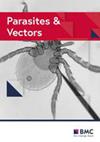大鼠肺线虫广东管圆线虫的生物学研究。
IF 3
2区 医学
Q1 PARASITOLOGY
引用次数: 0
摘要
广州管圆线虫是一种具有复杂生命周期的寄生线虫,以大鼠为终宿主,腹足类为中间宿主。这种寄生虫可以感染包括人类在内的其他生物体,从而导致神经血管线虫病,这是一种全球新出现但被忽视的疾病。本文综述了广东拟南芥的生物学,包括其在自然寄主、偶然寄主和副寄主中的生命周期和发育,以及其不断扩大的地理分布。然后,它考虑了广东棘虫研究的最新进展,随后探索了对这种迷人的寄生虫进行进一步研究的成熟地区。本文章由计算机程序翻译,如有差异,请以英文原文为准。
Insights into the biology of the rat lungworm, Angiostrongylus cantonensis.
Angiostrongylus cantonensis is a parasitic nematode with a complex life cycle involving rats as definitive hosts and gastropods as intermediate hosts. The parasite can infect other organisms, including humans, in which it causes neuroangiostrongyliasis, a globally emerging but neglected disease. This primer reviews the biology of A. cantonensis including its life cycle and development in its natural, accidental, and paratenic hosts, as well as its expanding geographic distribution. It then considers recent advances in A. cantonensis research followed by exploring areas that are ripe for further investigation into this fascinating parasite.
求助全文
通过发布文献求助,成功后即可免费获取论文全文。
去求助
来源期刊

Parasites & Vectors
医学-寄生虫学
CiteScore
6.30
自引率
9.40%
发文量
433
审稿时长
1.4 months
期刊介绍:
Parasites & Vectors is an open access, peer-reviewed online journal dealing with the biology of parasites, parasitic diseases, intermediate hosts, vectors and vector-borne pathogens. Manuscripts published in this journal will be available to all worldwide, with no barriers to access, immediately following acceptance. However, authors retain the copyright of their material and may use it, or distribute it, as they wish.
Manuscripts on all aspects of the basic and applied biology of parasites, intermediate hosts, vectors and vector-borne pathogens will be considered. In addition to the traditional and well-established areas of science in these fields, we also aim to provide a vehicle for publication of the rapidly developing resources and technology in parasite, intermediate host and vector genomics and their impacts on biological research. We are able to publish large datasets and extensive results, frequently associated with genomic and post-genomic technologies, which are not readily accommodated in traditional journals. Manuscripts addressing broader issues, for example economics, social sciences and global climate change in relation to parasites, vectors and disease control, are also welcomed.
 求助内容:
求助内容: 应助结果提醒方式:
应助结果提醒方式:


